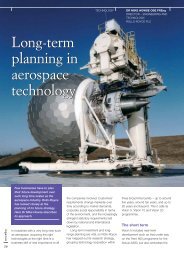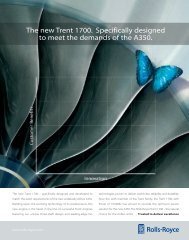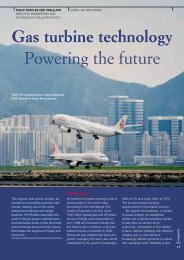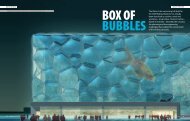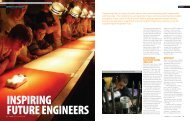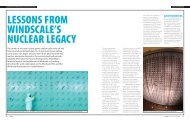You also want an ePaper? Increase the reach of your titles
YUMPU automatically turns print PDFs into web optimized ePapers that Google loves.
SEALING SOLUTIONS<br />
INNOVATION FEATURE<br />
Fluid leaks from a<br />
defect in the pipeline<br />
42 INGENIA ISSUE 29 DECEMBER 2006<br />
Platelets® introduced<br />
into line and carried to<br />
the leak site with fluid<br />
flow<br />
In 1998, Ian McEwan, a Reader from the<br />
University of Aberdeen, was travelling on<br />
a train reading an article about leakage<br />
problems in the UK water industry, and cut<br />
his finger on the paper. This cut, and its<br />
subsequent healing, led Ian to question<br />
whether the method the human body uses<br />
to seal cuts and wounds could be adapted<br />
for use in pressurised pipelines. Here, the<br />
concept of Platelet Technology was born.<br />
Platelets in the human body are<br />
irregularly-shaped, discrete particles which<br />
constantly patrol our veins. When bleeding<br />
from a wound occurs the platelets react,<br />
gathering at the leak site and attempting to<br />
stem the blood flow. Ian sought to take this<br />
concept and adapt it for use in industrial<br />
pipelines using his research field of particle<br />
and flow mechanics. He surmised that<br />
discrete specially-designed particles could<br />
be injected into a pipeline at a position<br />
upstream of a known or suspected defect.<br />
The particles would then utilise the fluid flow<br />
inside the pipeline to travel to the leak site.<br />
GOING WITH THE FLOW<br />
Designing these particles with the necessary<br />
material properties would enable fluid forces<br />
to draw them into the leak and hold them<br />
against the pipe wall, thus facilitating sealing.<br />
By embedding a remote tagging device into<br />
these discrete particles prior to deployment<br />
they can also be used to locate leaks. Once<br />
the particle is entrained into the defect the<br />
embedded tag is uniquely positioned at<br />
the leak site and can be detected by running<br />
a suitable device either externally or<br />
internally along the length of the pipeline.<br />
Platelet Technology enables leaks to be<br />
sealed and located in a single integrated<br />
process. This reduces the lifetime of the leak,<br />
which helps to limit any consequential<br />
environmental damage. Platelets® are<br />
A number of Platelets®<br />
become entrained into<br />
the leak<br />
implemented remotely, removing the need<br />
for direct access to the leak site which helps<br />
to ensure the safety of those involved in<br />
the repair. In addition, Platelets require no<br />
disturbance to pipeline operation meaning<br />
that, in some cases, costly shutdowns can<br />
be avoided.<br />
A BESPOKE SYSTEM<br />
The material that a batch of Platelets is<br />
made from is dictated by the environment<br />
in which it must operate. For example, fluid<br />
compatibility is a strong consideration when<br />
selecting the optimum material for a specific<br />
operation. A material must be selected<br />
which is not adversely affected by the carrier<br />
fluid for the required duration of the Platelet<br />
seal, which in some organic, high<br />
pressure/high temperature applications<br />
can prove very challenging.<br />
The operating pressure of the line also<br />
has a strong bearing on the selection of<br />
Platelet material – if the material is too soft<br />
it may be entirely extruded through the leak,<br />
but if the material is too hard a complete<br />
seal may not be attainable. For this reason<br />
a wide variety of materials have been used<br />
on Platelet operations to date, for which the<br />
pressures have varied from 2 to over 500 bar.<br />
MADE TO MEASURE<br />
The exact size and shape of a Platelet cannot<br />
be defined because it varies from operation<br />
to operation. For each operation undertaken<br />
by Brinker Technology, unique batches of<br />
Platelets are manufactured with properties<br />
which are specifically tuned to give the<br />
optimum results under the operating<br />
conditions in question. To give some idea,<br />
in projects carried out to date, defect sizes<br />
ranging from 0.3mm to 50mm diameter<br />
have been successfully sealed.<br />
Seal achieved – excess<br />
Platelets® continue<br />
down the line<br />
Platelets®<br />
Detection process can<br />
be carried out<br />
Platelets utilise the turbulent flow in pipelines<br />
to become evenly distributed across the<br />
pipeline cross-section, enabling leaks at any<br />
location to be targeted. To do this they need<br />
to be neutrally buoyant in the carrier fluid (ie<br />
the same density) and therefore this too affects<br />
the choice of material for each application.<br />
As such, there is no hard and fast rule which<br />
governs what a Platelet is made from; however,<br />
polymeric and elastomeric materials have<br />
demonstrated a good combination of<br />
properties for most applications.<br />
BACKGROUND PREPARATIONS<br />
Although the concept is elegant in its<br />
simplicity, underpinning the theory is<br />
extensive use of Computational Fluid<br />
Dynamics (CFD) in conjunction with Finite<br />
Element Analysis, plus over five years of<br />
rigorous physical testing. In non-urgent uses,<br />
when presented with a new application the<br />
first stage in the engineering process is to<br />
The use of both physical and numerical tools is crucial to<br />
the success of the entire approach because it gives much<br />
confidence in the quality and robustness of the solution.<br />
Particle traces coloured by velocity magnitude (m/s)<br />
Particle traces coloured by particle residence time (s)<br />
Figures 2 and 3. Computational Fluid Dynamics is used to assess Platelet entrainment rates © Brinker Technology<br />
INGENIA ISSUE 29 DECEMBER 2006 43





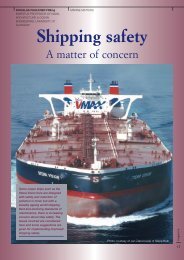


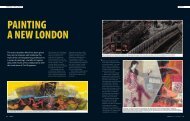
![[322/03] Francke - Ingenia](https://img.yumpu.com/23411337/1/184x260/322-03-francke-ingenia.jpg?quality=85)

